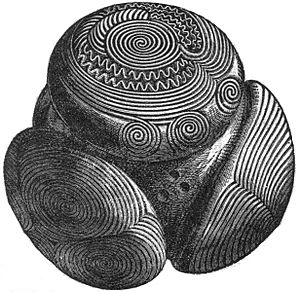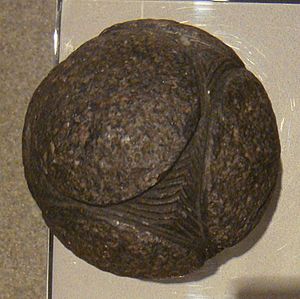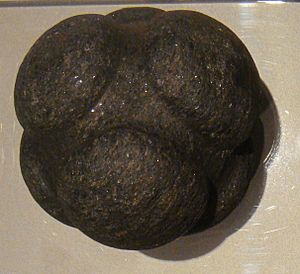Carved stone balls facts for kids


Carved stone balls are mysterious round stones made long ago, mostly during the late Neolithic period (New Stone Age). Some might even be from the later Iron Age. Most of these cool objects have been found in Scotland, but a few have also turned up in other parts of Britain and Ireland.
These balls are usually round, though a few are oval. They are pretty much the same size, about 7 centimeters (2.75 inches) across. What makes them special are the bumps, or "knobs," sticking out from their surface. Some have just 3 knobs, while others can have as many as 160! Their surfaces can be plain, or they can be covered in amazing, detailed patterns.
Scientists and historians have many ideas about what these carved stone balls were used for, but no one theory has been fully proven yet. They are different from the much larger, smooth stone spheres of Costa Rica.
Contents
When and Where Were They Found?
Carved stone balls are very old, some dating back as far as 5,200 years ago. This means they were made from the late Stone Age (Neolithic period) into at least the Bronze Age.
Most of these balls have been discovered in north-east Scotland, especially in a fertile area called Aberdeenshire. This is the land east of the Grampian Mountains. Because they are found in similar places to ancient Pictish symbols, some people first thought they were made by the Picts. The areas where they are found also match where many Recumbent stone circles are located.
These balls are small and easy to carry. Some have been found far from Aberdeenshire, on islands like Iona, Skye, Harris, Uist, Lewis, Arran, and in places like Orkney. Outside Scotland, they have been found in Ireland (at Ballymena) and England (in Durham, Cumbria, Lowick, and Bridlington). The biggest balls (about 90mm wide) almost all come from Aberdeenshire.
By the late 1970s, about 387 carved stone balls had been recorded. The largest number (169) were from Aberdeenshire. By 2015, over 425 balls had been found. The British Museum has a collection of more than 30 carved balls from Scotland, Ireland, and northern England.
How Were They Found?
Many carved stone balls were found by accident, often during farming work. We don't always know exactly where they were discovered. Five balls were found at Skara Brae, an ancient Stone Age village, and one at the Dunadd hillfort.
The places where these balls are found are similar to where mace-heads were discovered. Mace-heads were used as both weapons and special objects in ceremonies. Because many balls were found by chance, it's hard to know their original purpose. People were more likely to pick up and keep pretty, decorated balls, so we might not have a full picture of all the types that existed.
In 2013, archaeologists found a carved stone ball at Ness of Brodgar. This was a special discovery because it was found exactly where it had been left long ago, in a modern archaeological dig.
What Are They Like?
What They Are Made Of
Many balls are made of "greenstone," which is a general name for dark, greenish rocks like diorite or serpentinite. Forty-three balls are made of sandstone, and 26 are greenstone. Twelve are made of quartzite. Nine balls are made of serpentinite, and these were carved. Some were even made from gabbro, which is a very hard rock to carve.
Some balls are made from very tough stones like Hornblende gneiss and granitic gneiss. The famous Towie ball might be made of a type of serpentinized picrite. The balls with the most detailed decorations were usually made of sandstone or serpentine. Many balls still need to be fully examined to find out what kind of stone they are made from.
Making Replicas
A researcher named Andrew T. Young from the University of Exeter has made exact copies of these balls. He used old techniques like pecking (hitting with another stone) and grinding. This showed that the balls could have been made using only tools from prehistoric times, without any metal tools.
Size, Shape, and Knobs
Out of the 387 carved stone balls known in 1976 (now over 425), 375 are about 70 millimeters (about 2.75 inches) across. This is roughly the size of a tennis ball or an orange. Only 12 are larger (90 to 114 mm), and only 7 are oval-shaped.
The number of knobs on the balls varies a lot:
- Almost half have 6 knobs.
- A few have 3, 4, 5, 7, 8, or 9 knobs.
- 52 balls have between 10 and 55 knobs.
- 14 balls have between 70 and 160 knobs!
Decorations
The decorations on the balls fall into three main types:
- Spirals
- Concentric circles (circles inside other circles)
- Patterns of straight lines and cross-hatching
Sometimes, more than one type of design is used on the same ball. The quality of the carving ranges from very simple to incredibly detailed, showing that some were made by highly skilled artists. Some balls even have designs in the spaces between the knobs, which might be important for understanding their use.
Twenty-six of the six-knobbed balls are decorated. The balls found in Orkney are special because almost all of them are decorated, and they don't often have the common six-knobbed design. Some designs might have been made using metal tools.
The Towie ball has designs similar to those found on the Folkton Drums, which are chalk objects found in England. These drums have carvings that look like eyes. The concentric circles on some stone balls might also be stylized eyes. The Towie ball also has three dots arranged in a triangle between its knobs. This pattern is exactly like one found on a Pictish silver chain near Aberdeen. It's possible these dots represented a name, as some Pictish symbols are thought to be names.
Spiral patterns similar to those on "Grooved Ware" pottery (a type of Stone Age pottery) are found on balls from Aberdeenshire. These patterns are also seen on carvings at Newgrange in Ireland. Other designs include zig-zags and triangles. Most of the knobs on a single ball have different decorations, or sometimes no decoration at all. A few balls have a "golf-ball" like pattern. The carvings generally don't seem to have a practical purpose. However, one type of ball with very distinct knobs might have been used to process copper ores. Some bold triangles and criss-cross lines look more like designs from the Iron Age than the Stone Age or Bronze Age.
What Were They Used For?
People have many ideas about what carved stone balls were used for:
- Weapons: Some balls have grooves or spaces between the knobs where leather could be tied, perhaps to make a weapon like a bolas (a throwing weapon with weights on cords). However, many researchers now think they were probably not used as weapons.
- Weighing Tools: One idea was that they were weights for a simple weighing machine, because many are so similar in size. But studies have shown their weights vary too much for them to be part of a precise weighing system.
- Fishing Net Weights: Some similar "sink stones" found in Denmark and Ireland were used to weigh down fishing nets.
- Oracles: It has been suggested that the balls were used as oracles. People might have rolled them, and the way the ball landed could have been seen as a message from the gods or an answer to a question. Since few balls are found in graves, they might not have belonged to individuals.
- Talking Sticks: Another idea is that they were used to control discussions. The person holding the carved stone ball would have the "right to speak," while others would listen. The balls fit comfortably in one hand.
- Working Hides: The stones might have been used for preparing animal hides (leather). Leatherworkers used to polish hides by tying them to a frame with a ball at each corner. The corners of the hides were wrapped around the balls to hold them tightly.
- Megalith Construction Aid:
A new idea suggests that these balls might have helped move huge stones for building ancient monuments. This idea came from noticing that many carved stone balls are found near stone circles in Aberdeenshire, Scotland. They might have acted like ball bearings.
Many Stone Age balls have diameters that differ by only a millimeter, suggesting they were meant to be used together. If you place small wooden balls in grooves between parallel wooden "sleepers" (long pieces of wood), and then put a heavy carrying board on top, it shows that moving large stones this way could have been possible.
Platonic Solids
Some people believe that the carved stone balls show that ancient people understood the five Platonic solids (special 3D shapes) a thousand years before the Greek philosopher Plato described them. Some balls do have patterns that look like these shapes. However, it's debated how much this shows real mathematical understanding, as such patterns can naturally appear when placing bumps around a sphere. Also, not all five Platonic solids seem to be represented, and there isn't much evidence that these specific arrangements were more important than others.
See also
 In Spanish: Bola de piedra tallada para niños
In Spanish: Bola de piedra tallada para niños






